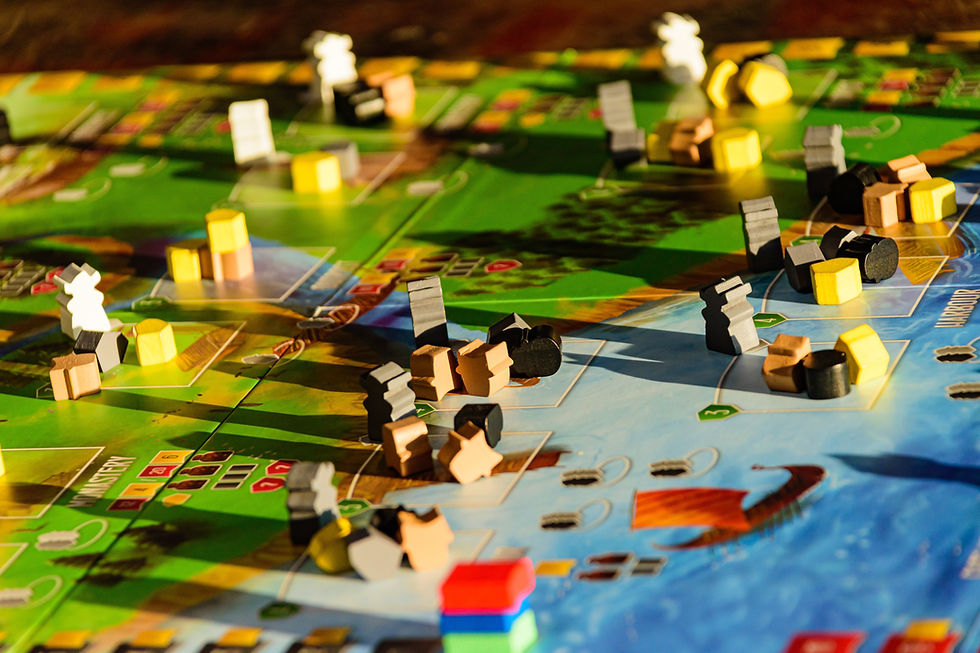Switch to Steam and Tabletop Simulator
- Logan Miles

- Apr 22, 2020
- 4 min read
Updated: Apr 29, 2020
This guide will help experienced board game hosts setup a board game night in Tabletop Simulator on Steam.

About Steam and Tabletop Simulator
Steam (https://store.steampowered.com/) is a video game distribution service provided by the company valve. It has thousands of games available to play, one of which, Tabletop Simulator, will help you transition your game nights to a digital format.
Tabletop Simulator has only 15 games upon installation, but what makes this service unique is the ability for users to create and share their own games. This has led to thousands of games being recreated and shared within the platform with many large gaming companies creating and sharing officially licensed versions of some of the biggest games hitting the table today.
Because most of the games on Tabletop Simulator are created uniquely, the features and components used from game to game vary greatly. Some games have partially or fully automated feature that replicate many of the real-world mechanics of the game. An example could be automated shuffling in a game that requires a certain amount of cards shuffled and dealt to players each round.

Screenshot of Tabletop Simulator with "Fantastic Factories" Board Game
Overall, playing a game on Tabletop Simulator is very similar to playing a game in real life. Steam has built in voice chat native to its platform so when utilizing this application you do not need to worry about also running Zoom or some other teleconferencing software to keep in touch with the other players.
Overall, playing a game on Tabletop Simulator is very similar to playing a game in real life.
Potential Limitation: Utilizing Steam requires every member of your game group to create an account on Steam as well as download and install the Steam client and the Tabletop Simulator application.
The guide below provides a step-by-step guide for how to set up and use Tabletop Simulator for your next remote game night.
Creating an Account
Begin by opening your browser and going to https://store.steampowered.com. From here you will need to create an account. You can create an account by clicking on “Log In” and then choosing “Create Account”.
Once you have created your account, you will need to download and install the Steam client from their homepage. Once the client is installed you can launch the Steam Store. From here you will search “Tabletop Simulator” and download the application.
Once the application is downloaded and installed, you can launch the application and you can begin to look through the lists of new and featured games. There is also a search tool available that allows you to search for games you’d like to play.

Screenshot of Tabletop Simulator with "Epic Munchkin" Board Game
Hosting a Game
Many of the games on Tabletop Simulator are free but there are also many that charge money for you to access them. To host a game, all players must download the DLC ("Downloadable Content") for that game from Tabletop Simulator on Steam. If it is a DLC that costs money, then only the host needs to pay the fee to "unlock" the game and everyone else just needs to download the content.
Once everyone has the content needed the host can invite the other players to the game using Steams built in invite friends feature. This allows the host to invite the others by simply inputting their Steam name to send them an invite.

Screenshot of Tabletop Simulator with "Gloomhaven" Board Game
Starting a Game
Once everyone has joined the game by accepting their invite, the host will have the option of selecting “Launch” to begin the game.
Once the game is loaded, you will see the actual playing field with the game board and necessary pieces. Depending on how each DLC game was programmed you may see a tutorial window will automatically appear and begin walking you through various aspects of the game.
After the tutorial is complete, if included, you’ll be left looking at the game board with various icons around the screen. Icons appear are depending on the game you are playing but the "Menu", "Host", "Notebook", and "Flip Table" icons are always available.
How each of these icons is used can vary based on the programming of the DLC:
The “Menu” button almost always has the settings options for the game that can be changed.
The “Host” button will allow certain restrictions the host can set, such as play order etc.
The “Notebook” allows for either notes to be taken or can be used to access the rulebook
The “Flip Table” is just a fun animation to hit, that is programmed in to simulate getting angry and flipping the table. Don’t worry; the pieces will reset afterwards.
If you ever have a question about what any of these or any additional icons that may be present in a game are simply hit the (?) question mark key or the (/) forward slash key as one of these two keys will always bring up the help menu while in game.

Screenshot of Tabletop Simulator with "Magic: The Gathering" Card Game
Gameplay
How gameplay works within a game is heavily dependent on how it was programmed. It may have strict built-in turn order (the order in which players perform actions), it may allow anyone to move any piece at any time. As this can vary so much, the host is highly encouraged to log into a game prior to the game night to make sure they understand how the game is programed to function.
This concludes our walk-through on Tabletop Simulator on the Steam platform. If you have further questions, feel free to utilize Steam's Help Page for more in depth information or Tabletop Simulator’s Knowledge Base for more information.
Steam, Tabletop Simulator, Zoom, Fantastic Factories, Magic: The Gathering, Gloomhaven, and Epic Munchkin are registered trademarks of their respective entities.
Comments